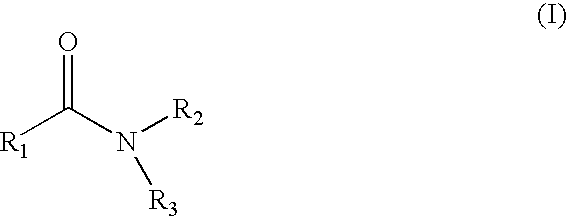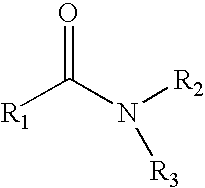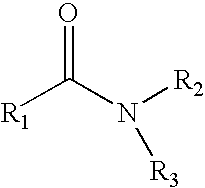Low odor, low volatility solvent for agricultural chemicals
a low volatility, agricultural chemical technology, applied in the field of solvents, can solve the problems of poor solvency of agricultural chemicals, high water solubility, and many common solvents showing either
- Summary
- Abstract
- Description
- Claims
- Application Information
AI Technical Summary
Problems solved by technology
Method used
Image
Examples
example 1
[0117]An amide solvent is formed from “C-810” fatty acid, which is a light cut fatty acid commercially available from Proctor & Gamble. “C-810” includes 3-5 wt. % C6 fatty acid, 53-60 wt. % C8 fatty acid, 34-42 wt. % C10 fatty acid, and 0-2 wt. % C12 fatty acid. The “C-810” is reacted with morpholine to form the amide solvent, referred to herein as “C-810 morpholine amide solvent.”
[0118]Morpholine (552 g, 6.35 moles) and “C810” (978 g, 6.35 moles) are placed in a 3-liter glass reactor equipped with an overhead stirrer and a Dean-Stark trap for removing water. The mixture is heated to 150° C. and is stirred for 6 hours, during which time the reaction bi-product (water) is continuously removed by means of the Dean-Stark trap. After water ceases to be collected, an additional amount of morpholine is added to the reactor (approximately 52 g, 0.6 moles). The temperature is held at 150° C. for 2 additional hours with stirring. The temperature is raised to 170° C. and the remaining morphol...
example 2
[0119]The C-810 morpholine amide solvent is mixed with the following components to form a herbicide emulsifiable concentrate (propanil EC): propanil, technical 45 wt. %; morpholine amide 43 wt. %; and emulsifier blend 12 wt. %.
example 3
[0120]A series of experiments are performed to determine an amount of an agricultural component to be included in an emulsifiable concentrate without recrystallization of the agricultural component. Table 1 illustrates the highest test amount of agricultural component that dissolves in the solvent composition at approximately 25° C. The amount that dissolves is determined through blending an amount of the agricultural component with the solvent composition and an emulsifier blend, and storing the resulting solution at 0° C. for 2 weeks. If no crystal growth is observed, the amount is determined to have dissolved.
[0121]Table 1 illustrates the parts agricultural component, the pairs solvent composition, and the ratio of the parts agricultural component to the parts solvent composition. In this example, the solvent composition is the C-810 morpholine amide solvent.
TABLE 1Solvency of Agricultural Component (AC)AgriculturalSolventAgriculturalComponentCompositionRatioComponent(parts)(part...
PUM
| Property | Measurement | Unit |
|---|---|---|
| temperature | aaaaa | aaaaa |
| temperature | aaaaa | aaaaa |
| wt. % | aaaaa | aaaaa |
Abstract
Description
Claims
Application Information
 Login to View More
Login to View More - R&D
- Intellectual Property
- Life Sciences
- Materials
- Tech Scout
- Unparalleled Data Quality
- Higher Quality Content
- 60% Fewer Hallucinations
Browse by: Latest US Patents, China's latest patents, Technical Efficacy Thesaurus, Application Domain, Technology Topic, Popular Technical Reports.
© 2025 PatSnap. All rights reserved.Legal|Privacy policy|Modern Slavery Act Transparency Statement|Sitemap|About US| Contact US: help@patsnap.com



